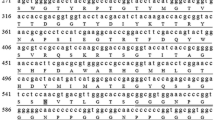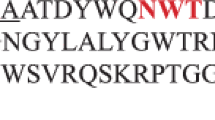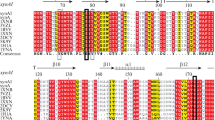Abstract
A cDNA gene (Auxyn10A), which encodes a mesophilic family 10 xylanase from Aspergillus usamii E001 (abbreviated to AuXyn10A), was amplified and inserted into the XhoI and NotI sites of pPIC9KM vector constructed from a parent pPIC9K. The recombinant expression vector, designated pPIC9KM-Auxyn10A, was transformed into Pichia pastoris GS115. All P. pastoris transformants were spread on a MD plate, and then inoculated on geneticin G418-containing YPD plates for screening multiple copies of integration of the Auxyn10A. One transformant expressing the highest recombinant AuXyn10A (reAuXyn10A) activity of 368.6 U/ml, numbered as P. pastoris GSX10A4-14, was selected by flask expression test. SDS-PAGE assay demonstrated that the reAuXyn10A was extracellularly expressed with an apparent M.W. of 39.8 kDa. The purified reAuXyn10A displayed the maximum activity at pH 5.5 and 50 °C. It was highly stable at a broad pH range of 4.5–8.5, and at a temperature of 45 °C. Its activity was not significantly affected by EDTA and several metal ions except Mn2+, which caused a strong inhibition. The K m and V max, towards birchwood xylan at pH 5.5 and 50 °C, were 2.25 mg/ml and 6,267 U/mg, respectively. TLC analysis verified that the AuXyn10A is an endo-β-1,4-d-xylanase, which yielded a major product of xylotriose and a small amount of xylose, xylotetraose, and xylopentose from birchwood xylan, but no xylobiose.





Similar content being viewed by others
References
Berrin JG, Juge N (2008) Factors affecting xylanase functionality in the degradation of arabinoxylans. Biotechnol Lett 30:1139–1150
Biely P, Vršanská M, Tenkanen M, Kluepfel D (1997) Endo-β-1,4-xylanase families: differences in catalytic properties. J Biotechnol 57:151–166
Bradford MM (1976) A rapid and sensitive method for the quantitation of microgram quantities of protein utilizing the principle of protein–dye binding. Anal Biochem 72:248–254
Chantasingh D, Pootanakit K, Champreda V, Kanokratana P, Eurwilaichitr L (2006) Cloning, expression, and characterization of a xylanase 10 from Aspergillus terreus (BCC129) in Pichia pastoris. Protein Express Purif 46:143–149
Chen XL, Cao YH, Ding YH, Lu WQ, Li DF (2007) Cloning, functional expression and characterization of Aspergillus sulphureus β-mannanase in Pichia pastoris. J Biotechnol 128:452–461
Chen XZ, Xu SQ, Zhu MS, Cui LS, Zhu H, Liang YX, Zhang ZM (2010) Site-directed mutagenesis of an Aspergillus niger xylanase B and its expression, purification and enzymatic characterization in Pichia pastoris. Process Biochem 45:75–80
Collins T, Gerday C, Fellar G (2005) Xylanases, xylanase families and extremophilic xylanases. FEMS Microbiol Rev 29:3–23
Coughlan MP, Hazlewood GP (1993) β-1,4-d-Xylan-degrading enzyme systems: biochemistry, molecular biology and applications. Biotechnol Appl Biochem 17:259–289
Fu DD, **e H, Wu MC (2005) Solid fermentation for xylanase production by Aspergillus usamii. Food Ferment Ind 31:50–53
Gaffney M, Carberry S, Doyle S, Murphy R (2009) Purification and characterization of a xylanase from Thermomyces lanuginosus and its functional expression by Pichia pastoris. Enzyme Microb Technol 45:348–354
Laemmli UK (1970) Cleavage of structural proteins during the assembly of the head of bacteriophage T4. Nature 227:680–685
Larson SB, Day J, Barba de la Rosa AP, Keen NT, McPherson A (2003) First crystallographic structure of a xylanase from glycoside hydrolase family 5: implications for catalysis. Biochemistry 42:8411–8422
Li JF, Zhao SG, Tang CD, Wang JQ, Wu MC (2012) Cloning and functional expression of an acidophilic β-mannanase gene (Anman5A) from Aspergillus niger LW-1 in Pichia pastoris. J Agric Food Chem 60:765–773
Li JF, Tang CD, Shi HL, Wu MC (2011) Cloning and optimized expression of a neutral endoglucanase gene (ncel5A) from Volvariella volvacea WX32 in Pichia pastoris. J Biosci Bioeng 111:537–540
Liu MQ, Liu GF (2008) Expression of recombinant Bacillus licheniformis xylanase A in Pichia pastoris and xylooligosaccharides released from xylans by it. Protein Express Purif 57:101–107
Liu MQ, Weng XY, Sun JY (2006) Expression of recombinant Aspergillus niger xylanase A in Pichia pastoris and its action on xylan. Protein Expres Purif 48:292–299
Liu Y, Su C, Song XS, Tang YL, Bao ZH (2009) Construction of Pichia pastoris strain expressing salivary plasminogen activator from vampire bat (Desmodus rotundus). Chin J Biotech 25:566–574
Lu FX, Lu M, Lu ZX, Bie XM, Zhao HZ, Wang Y (2008) Purification and characterization of xylanase from Aspergillus ficuum AF-98. Biores Technol 99:5938–5941
Luo HY, Yang J, Li J, Shi PJ, Huang HQ, Bai YG, Fan YL, Yao B (2010) Molecular cloning and characterization of the novel acidic xylanase XYLD from Bispora sp. MEY-1 that is homologous to family 30 glycosyl hydrolases. Appl Microbiol Biotechnol 86:1829–1839
Miller GL (1959) Use of dinitrosalicylic acid reagent for determination of reducing sugar. Anal Chem 31:246–248
Moukouli M, Topakas E, Christakopoulos P (2011) Cloning and optimized expression of a GH-11 xylanase from Fusarium oxysporum in Pichia pastoris. New Biotechnol 28:369–374
Pastor FIJ, Gallardo O, Sanz-Aparicio J, Diaz P (2007) Xylanases: molecular properties and applications. In: Polaina J, MacCabe AP (eds) Industrial Enzymes. Springer, Berlin Heidelberg New York, pp 65–82
Polizeli MLTM, Rizzatti ACS, Monti R, Terenzi HF, Jorge JA, Amorim DS (2005) Xylanases from fungi: properties and industrial applications. Appl Microbiol Biotechnol 67:577–591
Ruanglek V, Sriprang R, Ratanaphan N, Tirawongsaroj P, Chantasigh D, Tanapongpipat S, Pootanakit K, Eurwilaichitr L (2007) Cloning, expression, characterization, and high cell-density production of recombinant endo-1,4-β-xylanase from Aspergillus niger in Pichia pastoris. Enzyme Microb Technol 41:19–25
Tan ZB, Li JF, Wu MC, Tang CD, Zhang HM, Wang JQ (2011) High-level heterologous expression of an alkaline lipase gene from Penicillium cyclopium PG37 in Pichia pastoris. World J Microbiol Biotechnol 27:2767–2774
Wang JQ, Zhang HM, Wu MC, Tang CD (2011) Cloning and sequence analysis of a novel xylanase gene, Auxyn10A, from Aspergillus usamii. Biotechnol Lett 33:1029–1038
Wu MC, Qian ZK, Jiang PH, Min TS, Sun CR, Huang WD (2003) Cloning of an alkaline lipase gene from Penicillium cyclopium and its expression in Escherichia coli. Lipids 38:191–199
Wu MC, Fu DD, Zhu J, **a MF (2005) Purification and some properties of two xylanases from Aspergillus usamii. J Food Sci Biotechnol 24:29–33
Wu MC, Wang JQ, Zhang HM, Tang CD, Gao JH, Tan ZB (2011) Cloning and sequence analysis of an acidophilic xylanase (XynI) gene from Aspergillus usamii E001. World J Microbiol Biotechnol 27:831–839
Zhou CY, Bai JY, Deng SS, Wang J, Zhu J, Wu MC, Wang W (2008) Cloning of a xylanase gene from Aspergillus usamii and its expression in Escherichia coli. Biores Technol 99:831–838
Zhou CY, Wang YT, Wu MC, Wang W, Li DF (2009) Heterologous expression of xylanase II from Aspergillus usamii in Pichia pastoris. Food Technol Biotechnol 47:90–95
Acknowledgments
This work was financially supported by the National Nature Science Foundation of China (No. 31101229) and the Fundamental Research Funds for the Central Universities of China (No. JUDCF11032). The authors are grateful to Prof. **anzhang Wu (School of Biotechnology, Jiangnan University) for providing technical assistance.
Author information
Authors and Affiliations
Corresponding author
Rights and permissions
About this article
Cite this article
Wang, JQ., Yin, X., Wu, MC. et al. Expression of a family 10 xylanase gene from Aspergillus usamii E001 in Pichia pastoris and characterization of the recombinant enzyme. J Ind Microbiol Biotechnol 40, 75–83 (2013). https://doi.org/10.1007/s10295-012-1201-2
Received:
Accepted:
Published:
Issue Date:
DOI: https://doi.org/10.1007/s10295-012-1201-2




